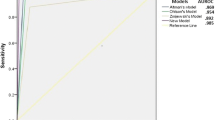Abstract
Analyzing the accounting reports of 8573 Russian companies, the article determined the threshold values of the indicators for known foreign and domestic bankruptcy probability models for ten sectors of the economy. The developed a ten-factor bankruptcy model is based on sector-specific threshold values and has a relatively high predictive power for the majority of sectors.
Similar content being viewed by others
References
E. Falkenstein, A. Boral, and L. Cartey, “RiskCalcTM for private companies: Moody’s default model,” Moody’s Investor Service: Global Credit Research, May, 3–86 (2000).
Credit Risk: A Credit Risk Management Framework, Credit Suisse Financial Products (Credit Suisse, New York, 1997).
T. Wilson, “Portfolio credit risk,” FRBNY Econ. Policy Rev., Oct., 71–82 (1998).
W. Beaver, “Financial ratios as predictors of failure. Empirical research in accounting selected studies,” J. Account. Res. (Suppl.), No. 4, 71–111 (1966).
E. I. Altman, “Financial ratios, discriminant analysis and the prediction of corporate bankruptcy,” J. Finance, No. 23, 589–609 (1968).
J. Ohlson, “Financial ratios and the probabilistic prediction of bankruptcy,” J. Account. Res., No. 18, 109–131 (1980).
J. Fulmer, J. Moon, T. Gavin, and M. Erwin, “A bankruptcy classification model for small firms,” J. Commer. Bank Lending, July, 25–37 (1984).
R. J. Taffler and H. J. Tisshaw, “Going, going, gone, four factors which predict,” Accountancy, No. 88 (1003), 50–52 (1977).
G. L. V. Springate, “Predicting the possibility of failure in a Canadian firm,” MBA Research Project (Simon Fraser University, 1978) (in press).
M. E. Zmijewski, “Methodological issues related to the estimation of financial distress prediction models,” J. Account. Res. (Suppl.), No. 22, 59–82 (1984).
E. S. Minaev and V. P. Panagushin, Crisis Management (Prior, Moscow, 1998) [in Russian].
O. P. Zaitseva, “Crisis management in the Russian firm,” Aval’, Sib. Finans. Shkola, Nos. 11–12 (1998).
G. V. Davydova and A. Yu. Belikov, “Methods of quantitative bankruptcy risk assessment,” Uprav. Riskom, No. 3, 13–20 (1999).
E. A. Fedorova, E. V. Gilenko, and S. E. Dovzhenko, Models for bankruptcy forecasting: Case study 159–164 (2013).
SPARK Database. https://www.spark-interfax.ru.
Ruslana Database. https://ruslana.bvdep.com.
A. Agresti, An Introduction to Categorical Data Analysis (Wiley, Hoboken, 2007).
Author information
Authors and Affiliations
Corresponding author
Additional information
Original Russian Text © E.A. Fedorova, S.E. Dovzhenko, F.Yu. Fedorov, 2016.
Rights and permissions
About this article
Cite this article
Fedorova, E.A., Dovzhenko, S.E. & Fedorov, F.Y. Bankruptcy-prediction models for Russian enterprises: Specific sector-related characteristics. Stud. Russ. Econ. Dev. 27, 254–261 (2016). https://doi.org/10.1134/S1075700716030060
Received:
Published:
Issue Date:
DOI: https://doi.org/10.1134/S1075700716030060




